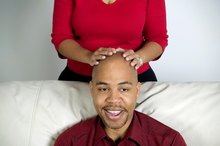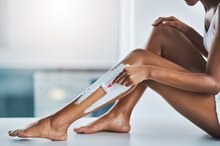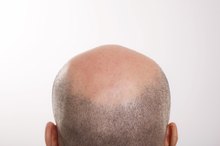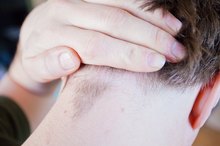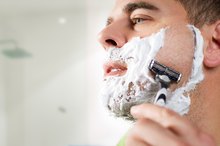Red Bumps When My Hair Grows Back
Red bumps that develop as hair grows back can be due to ingrown hairs. They can occur in anyone that removes body and facial hair through shaving, waxing, tweezing or electrolysis. Because these bumps can be painful and irritating, it is important to understand why they occur and how they can be remedied.
Definition
Ingrown hair can occur in both men and women. The bumps can appear anywhere hair is removed including the face, legs, pubic area, neck, scalp and armpits. Symptoms can include itchiness, the appearance of an embedded hair, darkening of the skin and localized pain. The bumps can also turn blister-like and contain pus.
- Ingrown hair can occur in both men and women.
- The bumps can appear anywhere hair is removed including the face, legs, pubic area, neck, scalp and armpits.
Causes
How to Remove Ingrown Arm Hair
Learn More
Ingrown hairs occur when the hair grows back into the hair follicle, causing an inflamed red bump. This reaction develops because the body does not recognize the hair and instead thinks it is a foreign body. These bumps can occur if a hair follicle is curved in shape, which produces a curly hair that can easily reenter the follicle. Pulling the skin during shaving or using a double-edged razor can also encourage the hair to retract, causing an ingrown hair.
- Ingrown hairs occur when the hair grows back into the hair follicle, causing an inflamed red bump.
- These bumps can occur if a hair follicle is curved in shape, which produces a curly hair that can easily reenter the follicle.
Treatment Options
The bumps of ingrown hairs can be treated by washing the skin with an antibacterial soap containing 10 percent benzoyl peroxide. This can help reduce any inflammation. In addition, over-the-counter cortisone cream can help speed up healing time and reduce the appearance of the red bumps. Use a new razor blade every time you shave if the bumps are infected of inflamed. This will help prevent irritation and reinfection.
- The bumps of ingrown hairs can be treated by washing the skin with an antibacterial soap containing 10 percent benzoyl peroxide.
Prevention
Home Treatment for Vaginal Ingrown Hairs
Learn More
To prevent the formation of the red bumps caused by ingrown hairs, Dr. Mary Stone, in “The Doctors Book of Home Remedies for Women,” recommends shaving instead of waxing 1. "Waxing is traumatic," she warns. "It rips out your hair at an angle." This can allow it to grow back in different directions instead of straight up and out of the follicle. Ensure you exfoliate skin before shaving. In addition, protect the hair follicles by always using shaving gels or foams to create a protective barrier between the skin and razor blade when shaving. Also, shave in the direction hair grows.
- To prevent the formation of the red bumps caused by ingrown hairs, Dr. Mary Stone, in “The Doctors Book of Home Remedies for Women,” recommends shaving instead of waxing 1. "
- In addition, protect the hair follicles by always using shaving gels or foams to create a protective barrier between the skin and razor blade when shaving.
Warnings
If the red bumps are chronic or do not respond to home treatments, consult a doctor or dermatologist. Left untreated, these bumps can become infected and may even lead to permanent scarring. In addition, sometimes ingrown hairs can occur as the result of excess hair growth caused by a potentially dangerous medical condition such as hirsutism.
Related Articles
References
- The Doctors Book of Home Remedies for Women; Sharon Faelten
- Allure: The 10 Biggest Hair-Removal Mistakes
- University of Rochester Medical Center: How to Prevent and Treat Ingrown Hairs
- MedlinePlus. Acne.
- Cleveland Clinic. Ingrown hair. Updated February 28, 2018.
- Merck Manuals. Ingrown beard hairs. Updated October 2019.
- Cleveland Clinic. Ingrown hair: Management and treatment. Updated February 28, 2018.
- Ogunbiyi A. Pseudofolliculitis barbae; current treatment options. Clin Cosmet Investig Dermatol. 2019;12:241-247. doi:10.2147/CCID.S149250
- MedlinePlus. Folliculitis. Updated October 8, 2018.
- Zaenglein AL, Pathy AL, Schlosser BJ, Alikhan A, Baldwin HE, et. al. Guidelines of care for the management of acne vulgaris. Journal of the American Academy of Dermatology. 2016; 74(5): 945-73. doi:10.1016/j.jaad.2015.12.037
Writer Bio
Rose Erickson has been a professional writer since 2010. She specializes in fitness, parenting, beauty, health, nutrition and saving money, and writes for several online publications including The Krazy Coupon Lady. She is also a novelist and a mother of three.

